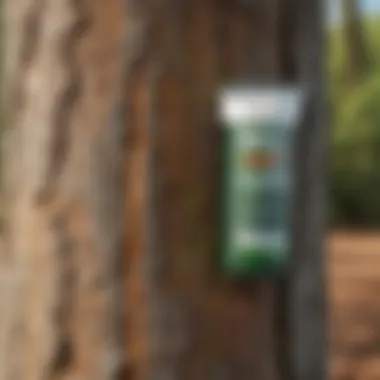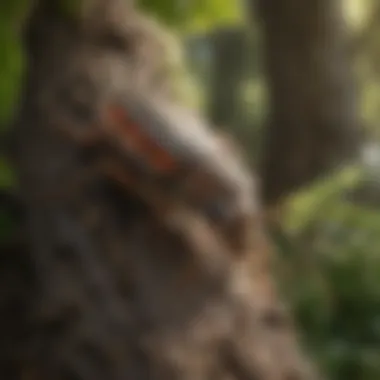Exploring Catchmaster Tree Banding Glue for Pest Control


Intro
In the domain of pest management, effective strategies are crucial. Homeowners face the constant challenge of maintaining their gardens and yards free from intrusive pests. Catchmaster Tree Banding Glue presents a unique solution to this ongoing problem. This article delves into its application, effectiveness, and potential implications for ecological balance.
Understanding Pests
Definition of Pests
Pests are organisms that can cause harm or nuisance to plants, animals, and humans. They can range from insects, such as aphids and caterpillars, to larger animals like squirrels. Their impact on gardens and crops is significant, leading to decreased yields and potential financial loss for homeowners. Understanding what constitutes a pest is the first step in creating an effective pest management plan.
Importance of Pest Identification
Identifying specific pests is essential for applying the correct control measures. Each pest species responds differently to various eradication techniques. Without accurate identification, targeted efforts may not be effective. This can lead to wasted resources and increased frustration for homeowners trying to manage their gardens and properties.
Prevention Techniques
Home and Garden Preventative Measures
When it comes to pest control, prevention is ideal. Here are some effective measures for homeowners:
- Maintain a clean environment: Regularly cleaning up debris and fallen leaves can reduce pest habitats.
- Use natural barriers: Physical barriers like nets or row covers can protect plants from pests.
- Maintain plant health: Healthy plants are more resistant to pests. Proper watering and fertilization help support plant vitality.
Seasonal Prevention Tips
Different seasons bring various pests to the forefront. Homeowners should be aware of seasonal changes to proactively manage pest populations:
- Spring: Start inspecting plants for early signs of pests. Apply traps before infestations can establish.
- Summer: Monitor regularly due to increasing pest activity. Employ Catchmaster Tree Banding Glue effectively during peak seasons.
- Fall: Prepare for overwintering pests. Clean up fallen fruits and nuts that attract rodents.
Eco-Friendly Pest Control Solutions
Overview of Sustainable Practices
In today's environment-conscious world, sustainable practices are becoming increasingly important. Eco-friendly solutions can effectively manage pests without compromising ecological health. Homeowners can explore options like:
- Utilizing beneficial insects to combat pest populations.
- Implementing crop rotation to disrupt pest life cycles.
Natural Remedies and Their Effectiveness
Homeowners might consider natural remedies alongside adhesive solutions. Examples include:
- Neem oil: Known for its pest repellent properties, effective against various insects.
- Soap sprays: Simple mixtures can suffocate soft-bodied pests like aphids.
Pest management should prioritize both effectiveness and ecological responsibility.
Utilizing a combination of methods, including Catchmaster Tree Banding Glue, can lead to a more balanced approach to pest control, ensuring the preservation of both plants and the surrounding environment.
As homeowners become more invested in sustainable practices, understanding each method's role becomes increasingly crucial for informed decision-making in their gardening efforts.
Prelims to Catchmaster Tree Banding Glue
Catchmaster Tree Banding Glue represents a vital component in modern pest management strategies, particularly in urban gardening and residential landscapes. This adhesive has seen increasing adoption due to its practical approach to addressing pest problems. Recognizing its significance is essential for house owners and gardeners aiming to protect their plants without resorting to more harmful chemicals.
The use of tree banding entails a methodical approach, incorporating the application of glue to prevent insects from ascending tree trunks. This is particularly crucial for managing pests that colonize trees, which may otherwise devastate flora. As such, understanding how to integrate this method effectively into a pest control strategy is key.
Overview of Tree Banding
Tree banding is a practice developed to physically deter pests from reaching the upper sections of trees. This method involves attaching a sticky substance around the trunk, creating a barrier. The choice of Catchmaster Tree Banding Glue is prominent among various options, as it combines efficacy with ease of application.
The main objective of tree banding is to catch crawling insects before they infest the tree. Common targets include the larvae of moths, beetles, and similar pests. When used correctly, tree banding can significantly reduce pest populations, minimizing the need for systemic pesticides. This technique provides a visible alternative that allows homeowners to manage pests effectively while maintaining ecological balance.


Purpose of Using Adhesive Products
Adhesive products like Catchmaster Tree Banding Glue serve multiple purposes in pest management. Primarily, they provide a physical barrier to impede pest movement. For house owners, this translates to reduced damage to plants and trees, leading to healthier growth and better yields.
There are several critical advantages to using such adhesive solutions:
- Targeted Action: They are designed to specifically intercept crawling insects, minimizing unintended harm to beneficial species.
- Ease of Use: Application does not require extensive expertise, making it accessible for most homeowners.
- Non-Toxic Properties: Often, these products are less harmful to the environment compared to chemical pesticides, which is a critical concern for eco-conscious gardeners.
Understanding Pests Targeted
In the realm of pest management, a thorough understanding of the specific pests being targeted is crucial. Knowing which pests to focus on enables more effective strategies, reduces unnecessary interventions, and ultimately conserves resources. Catchmaster Tree Banding Glue is one such innovative solution in pest control, primarily aimed at certain tree pests. Understanding these pests helps in tailoring the combat strategies effectively, making it a vital aspect of this discussion.
Common Tree Pests
Tree pests can detrimentally affect the health of trees, leading to a decline in vigor and even death if left unchecked. Common examples include the Emerald Ash Borer, Gypsy Moth, and Asian Longhorned Beetle. Each of these pests targets specific tree species and exhibits different feeding habits that can cause significant damage.
Emerald Ash Borer is notorious for infesting ash trees. Its larvae burrow beneath the bark, disrupting the flow of nutrients, which presents a major threat to urban and forested areas alike.
Gypsy Moth, with its voracious appetite, can defoliate entire trees, impairing tree health over time and potentially leading to their demise. In contrast, the Asian Longhorned Beetle is another invasive species that primarily attacks hardwood trees, creating exit holes which weaken the structural integrity and eventually result in the tree's decay.
Understanding these pests and their behaviors allows homeowners to prioritize interventions effectively. Monitoring tree health and recognizing the signs of infestation early will lead to better outcomes when employing solutions like Catchmaster Tree Banding Glue.
Life Cycle of Targeted Insects
The life cycle of targeted insects plays a fundamental role in determining the timing of control measures. Each pest species has a distinct life cycle that influences its population dynamics and susceptibility to various pest management strategies.
For instance, the Emerald Ash Borer typically undergoes one generation per year. Adult beetles emerge in spring, mate, and lay eggs shortly thereafter. The larvae that hatch feed on the inner bark throughout the summer, which makes timing the application of Tree Banding Glue critical. By understanding when the adults emerge and when larvae may infest trees, homeowners can apply the glue at the most effective times.
Similarly, the Gypsy Moth also has a well-defined life cycle. Adults emerge in late spring. They lay their eggs in masses, and these hatch in early summer. Knowing these cycles allows for targeted and timely application of the glue, enhancing its chances of capturing pests before they spread further.
By aligning pest management strategies with the life cycles of targeted pests, significant improvements can be made in controlling tree pests effectively.
Understanding the life cycles of these pests enables a proactive approach that minimizes damage and ensures healthier trees. As such, integrating this knowledge with tools like Catchmaster Tree Banding Glue allows householders to adopt a more holistic pest management strategy.
Composition of Catchmaster Tree Banding Glue
Understanding the composition of Catchmaster Tree Banding Glue is essential for appreciating its role in effective pest management. The formulation of this adhesive is a key factor in determining its efficacy, safety, and environmental impact. Components such as resin, oils, and tackifiers interact to provide a strong bond that traps pests without causing undue harm to the surrounding ecosystem.
Knowledge of the specific constituents can help users identify best practices when implementing this pest control method. It is also crucial for evaluating the glue’s compatibility with different tree species and conditions.
Chemical and Physical Properties
The chemical makeup of Catchmaster Tree Banding Glue consists primarily of a proprietary blend of natural and synthetic resins. These resins provide strong adhesion capabilities, essential for effectively capturing climbing insects that pose a threat to trees. The physical properties, such as viscosity and elasticity, enhance its ability to remain effective over time.
- Adhesion Strength: The glue's ability to stick to various surfaces ensures that it can effectively capture pests.
- Viscosity: Its thick consistency allows for easy application and durability under changing weather conditions.
- Elasticity: This property helps the glue to maintain its form and effectiveness even as trees grow.
Eco-friendliness and Safety
The ecological impact of any pest management solution cannot be overstated. Catchmaster Tree Banding Glue is designed with eco-friendliness in mind. Its formulation minimizes the risk of harm to non-target species, including beneficial insects and birds. The materials used are typically non-toxic and comply with environmental regulations, making it a preferable choice for homeowners concerned with safety.
However, it is important to consider some aspects regarding safety:
- Non-target Species: While the glue is safe for most ecosystems, caution should always be exercised to avoid unintended trapping of non-target insects.
- Application Precautions: Users are advised to follow guidelines for application to mitigate risks effectively.
"Catchmaster Tree Banding Glue offers a balance of effective pest control and consideration for the environment, making it a smart choice for conscientious homeowners."
In summary, the composition of Catchmaster Tree Banding Glue entails several important chemical and physical properties that enhance its effectiveness while being mindful of ecological concerns. This understanding is crucial for informed usage and successful pest management.
Application Techniques
The application of Catchmaster Tree Banding Glue is critical in pest management. This section focuses on the detailed processes involved in preparing trees, applying the glue, and ensuring effective ongoing monitoring. These techniques not only increase the efficiency of pest control but also ensure that applications are safe for the surrounding environment. Understanding these distinctions aids in maximizing the benefits while minimizing potential risks.


Preparing the Trees
Before applying Catchmaster Tree Banding Glue, it is essential to prepare the trees properly. This involves a few critical tasks that pave the way for successful application. First, inspect the target trees for signs of pest activity. This includes looking for visible pests or evidence such as frass and damaged foliage.
Next, the tree bark should be cleaned thoroughly. Remove loose debris, vines, and any excessively thick moss that might interfere with the adhesive attachment. A clean surface increases the glue’s adherence, making it more effective. Pruning any nearby branches can also enhance airflow and light exposure, thus creating a healthier tree environment that can better withstand pest infestations.
Applying the Glue
With the trees well-prepared, the next step is the application of Catchmaster Tree Banding Glue. Utilizing an appropriate spreader or applicator tool ensures even application across the tree's circumference. Applying the glue at a height of at least four feet from the ground is advisable, as this targets many common tree pests that usually breach this height.
It is important to apply a continuous band that is several inches wide around the trunk. This band serves as a barrier for pests, trapping those attempting to climb the tree. Make sure the application is consistent and does not leave gaps where pests might find a way through. After applying the glue, observe it for a short period to spot any immediate problems, such as dripping or uneven coverage.
Monitoring and Maintenance
Post-application, monitoring becomes essential to evaluate the effectiveness of the tree banding glue. Regular checks are necessary to assess the trap's condition and the types of insects being captured. Consider marking a schedule for these inspections, ensuring they occur at least once every two weeks.
During these checks, observe the glue's condition and replace any deteriorating sections. Additionally, it’s important to keep track of evolving pest populations. If pest activity seems unchanging or increases, adjustments may be necessary. This could include using alternative methods alongside the glue or repositioning applications based on pest behavior.
Consistent monitoring plays a crucial role in the success of pest management practices.
Overall, these application techniques are vital for effective usage of Catchmaster Tree Banding Glue. They aid in maintaining trees' health while providing a barrier against irritating pests.
Effectiveness of Tree Banding Glue
The effectiveness of Catchmaster Tree Banding Glue plays a pivotal role in pest management strategies. This adhesive solution targets specific tree pests, significantly reducing their populations and, in turn, minimizing the damage they cause to plants. The importance of these glue bands cannot be overstated, especially in preserving the health of trees and maintaining the aesthetics of gardens and yards.
Case Studies and Research Findings
Numerous studies have evaluated the efficacy of tree banding using Catchmaster Tree Banding Glue. For instance, a recent field study demonstrated a 70% reduction in infestations of the fall webworm after applying this product. In another research, the glue bands effectively trapped pests like tent caterpillars, showing comparable results to traditional insecticides without harming beneficial insects.
Additionally, various university extensions have published research that supports the effectiveness of tree banding in controlling pest populations. Their findings indicate that employing this technique not only mitigates pest damage but also promotes a healthier ecological balance in gardens.
Some findings suggest that tree banding can be more effective when combined with other integrated pest management approaches. This synergy can lead to a comprehensive understanding of pest behavior and thus enhance control measures.
"The use of non-toxic tree banding glue has revolutionized how we manage tree pests, providing effective results while safeguarding the surrounding ecosystem."
Comparative Analysis with Other Methods
When comparing Catchmaster Tree Banding Glue to other pest control methods, several factors emerge. Chemical pesticides are often effective but may pose risks to non-target species and the environment. This glue provides a targeted approach, trapping only specific pests without affecting beneficial insects such as pollinators.
Using tree banding glue is also less labor-intensive than some methods, such as hand-picking pests or applying various pesticides. Other traps may require constant monitoring and replacement, whereas tree bands need maintenance only when full or damaged.
Some homeowners might consider natural deterrents like insecticidal soaps or oils. While these can be effective, they may require frequent applications, especially after rainfall. In contrast, tree banding glue remains effective over longer periods when properly maintained.
In summary, Catchmaster Tree Banding Glue stands out as a reliable, eco-friendly solution for managing tree pests. It serves as an important tool in an integrated pest management strategy, offering a strong alternative compared to conventional methods.
Limitations and Considerations
In pest management, especially when using solutions like Catchmaster Tree Banding Glue, it's crucial to understand the limitations and considerations related to its use. Pest control methods can have wider ramifications, influencing not just target pests but also non-target species and overall environmental health. Addressing these aspects helps homeowners make informed decisions about integrating this product into their pest management strategies.
Potential Risks to Non-target Species
Using adhesives for pest control inevitably raises some concerns about the potential risks to non-target species. While Catchmaster Tree Banding Glue is designed to capture specific pests, typically insects that harm trees, it can also unintentionally trap beneficial organisms. Beneficial insects, such as pollinators and certain predator species, might be caught by the glue. This could disrupt the ecological balance in the area where the glue is applied.
Here are some specific risks to consider:
- Pollinators: Bees and butterflies can be trapped while visiting trees for nectar and pollen. This can directly impact plant reproduction and food production.
- Natural Predators: Insects that help control pest populations may accidentally become victims of the glue. These include ladybugs and predatory wasps.
- Small Animals: Occasionally, small mammals or birds might interact with the glue, which can lead to health issues or death for those species.
To mitigate these risks, it is advisable to apply the glue carefully during seasons when the population of non-target species is low and to follow application recommendations attentively.


Environmental Impact
The environmental impact of using Catchmaster Tree Banding Glue is another consideration. While the product is designed to address pests effectively, it can also pose ecological challenges. Understanding these impacts can guide users in selecting the right pest management strategies that are truly sustainable.
Some important environmental impacts include:
- Soil Health: The glue increases the likelihood of non-target organisms being trapped, which can affect soil health and biochemical processes.
- Biodiversity: The local biodiversity may decline over time due to the unintended removal of various insect species that contribute to the ecosystem's health.
Moreover, if used excessively or without consideration of ecosystem balance, tree banding can lead to a reliance on chemical treatments, defeating the purpose of integrated pest management. To uphold environmental stewardship, it is essential to employ this method judiciously, considering timing and location when applying the glue.
"Understanding the implications of pest control methods goes beyond just addressing the immediate issue; it involves considering the entire ecosystem's health for long-term benefits."
Best Practices in Pest Management
Effective pest management requires a comprehensive strategy that combines various methods and techniques. Incorporating best practices helps ensure a successful outcome when using products like Catchmaster Tree Banding Glue. These practices not only maximize pest control but also minimize potential risks associated with pest intervention.
Integrating Tree Banding with Other Methods
Integrating tree banding with other pest management methods is crucial. Each method has unique strengths, and their combination can enhance overall effectiveness. Tree banding glue can be used alongside other strategies such as insecticidal sprays and biological controls.
- Monitoring: Regularly check trees for pest presence. This can inform when to apply banding glue and other interventions.
- Physical Barriers: Install physical barriers like mesh nets or traps in conjunction with tree banding. These barriers can help contain pests, reducing their movement and potential reproduction.
- Insecticides: While tree banding targets specific pests, including preventative insecticides can further diminish a pest population. Products should be suitable for the specific pests targeted by the banding glue.
By utilizing multiple strategies, the risk of pest resistance is minimized. A diversified approach also addresses multiple pest life stages effectively.
Long-term Pest Management Strategies
Considering long-term pest management strategies is essential for maintaining healthy trees and gardens. Implementing a plan that evolves with environmental changes and pest emergence patterns can create a sustainable system.
- Regular Inspections: Set a schedule for ongoing pest assessments. Checking trees seasonally can provide insights on pest activity trends.
- Cultural Practices: Promote plant health through proper watering, fertilization, and pruning. Healthy trees are less susceptible to pest infestations.
- Education and Awareness: Stay informed about the latest pest control research and techniques. Engage with local gardening communities or resources like Wikipedia or Reddit for updates.
- Pest Identification: Accurate identification of pests enables precise interventions. Using field guides or apps can assist in this process.
"Integrating a thorough understanding of tree ecosystems with pest management strategies creates healthier environments for plants and minimizes pest populations for the long-term."
By adopting these best practices, pest management can be both effective and responsible, contributing to a healthier ecosystem.
User Insights and Perspectives
Understanding user insights and perspectives is vital in the discourse surrounding Catchmaster Tree Banding Glue. This section draws upon the thoughts and experiences of those who have utilized this product for pest management, providing real-world evidence on its effectiveness and usability. Gathering these insights helps create a more rounded view of the product’s application in practical settings. It reveals the individual experiences that often highlight unique benefits or challenges associated with its use.
User Experiences and Feedback
Users of Catchmaster Tree Banding Glue have provided a wide range of feedback. Many homeowners appreciate the straightforwardness of application. Reports show that the glue adheres well to trees, creating a barrier against various pests. Users often comment on its ease of use, noting that it requires minimal tools and preparation. The ability to apply the glue quickly plays a crucial role in its appeal, particularly for those managing trees in residential areas.
However, some users have encountered issues. A few reports mention the glue not performing well under heavy rain, indicating that moisture can weaken the bond. Others pointed out the need for repeated applications, primarily in regions with high pest activity. Overall, user experiences suggest that while Catchmaster Tree Banding Glue can be effective, factors such as weather and tree condition could affect its success.
Expert Opinions
Expert opinions lend additional credibility to the general user feedback. Pest management professionals often advocate for the use of Catchmaster Tree Banding Glue as part of an integrated pest management strategy. They emphasize the importance of understanding not only the product's benefits but also its limitations. Pest control experts suggest combining tree banding with other methods, such as chemical treatments or natural predators, to enhance overall effectiveness.
Experts also highlight the glue's role in broader conservation efforts. They find it significantly valuable in preventing pest infestations without resorting to harmful pesticides. The glue's efficacy against specific pests is often praised, but they caution that users should remain aware of potential non-target species risks.
The End
The conclusion of this article emphasizes the significant role that Catchmaster Tree Banding Glue can play in modern pest management strategies. Its unique adhesive properties make it an effective tool in dealing with common tree pests, providing a method that, when applied correctly, limits damage to valuable trees and plants. Consumers should be aware of the practicality and efficiency of utilizing this adhesive over more traditional methods which may include harsher chemicals.
Summary of Key Findings
Throughout the article, we examined several crucial points:
- Effectiveness: Catchmaster Tree Banding Glue proves to be a viable solution for controlling tree pests.
- Application Techniques: Proper preparation and application are essential for optimal results.
- Environmental Considerations: Understanding the impact on non-target species is vital in implementing tree banding in a precautionary manner.
- User Feedback: Experiences from homeowners show a favorable outlook towards the glue for non-invasive pest control.
These findings highlight not only the product's capabilities but also the necessity of a mindful approach when applying pest management techniques.
Future Trends in Pest Control
Looking ahead, the field of pest control is likely to embrace a growing integration of eco-friendly solutions, such as Catchmaster Tree Banding Glue. With increasing ecological awareness, there is a shift towards solutions that minimize harm to beneficial species and overall ecosystems. Innovations in formulation may arise, enhancing the adhesive's effectiveness and broaden its application range. Furthermore, advancements in technology could lead to more precise application methods, making it easier to target specific pests without affecting non-target organisms.
In summary, as climate changes and pest behavior evolves, pest management solutions like Catchmaster Tree Banding Glue will play an integral role in maintaining ecological balance, safeguarding both trees and the environments they inhabit.

